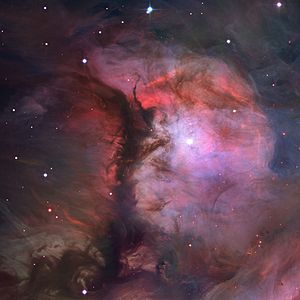| Emission nebula | |
|---|---|
| H II region | |
 Emission nebula Messier 43 in Orion Emission nebula Messier 43 in Orion | |
| Observation data: J2000 epoch | |
| Right ascension | 05 35 31.8 |
| Declination | −05° 17′ 57″ |
| Distance | 1,300 ± 160 ly (400 ± 50 pc) ly |
| Apparent magnitude (V) | 9.0 |
| Apparent dimensions (V) | 20′ × 15′ |
| Constellation | Orion |
| Notable features | Trapezium cluster |
| Designations | De Mairan's Nebula, M43, NGC 1982 |
| See also: Lists of nebulae | |
Messier 43 or M43, also known as De Mairan's Nebula and NGC 1982, is a star-forming nebula with a prominent H II region in the equatorial constellation of Orion. It was discovered by the French scientist Jean-Jacques d'Ortous de Mairan some time before 1731, then catalogued by Charles Messier in 1769. It is physically part of the Orion Nebula (Messier 42), separate from that main nebula by a dense lane of dust known as the northeast dark lane. It is part of the much larger Orion molecular cloud complex.
The main ionizing star in this nebula is HD 37061 (variable star designation NU Ori), the focus of the H II region, 1,300 ± 160 ly (400 ± 50 pc) away. This is a triple star system with the brighter component being a single-lined spectroscopic binary. The main component is a blue-white hued B-type main-sequence star with a stellar classification of B0.5V or B1V. It has 19±7 times the mass of the Sun (M☉) and 5.7±0.8 times the Sun's radius (R☉). It is radiating over 26,000 times the Sun's luminosity (L☉) from its photosphere at an effective temperature of 31,000 K. It is spinning rapidly with a projected rotational velocity of around 200 km/s.
The H II region is a roundish volume of ionized hydrogen. It has a diameter of about 4.5′, at its distance meaning it measures 2.1 ly (0.65 pc). The net (meaning omitting the star) hydrogen alpha luminosity of this region is (3.0±1.1)×10 erg s; equivalent to 78 L☉. There is a dark lane crossing the whole west-centre strip from north to south, known as the M43 dark lane, which forming a swirling belt extension to the south links to Orion's northeast dark lane. All of these resemble a mixture of smoke rising from a chimney and in watercolour broad and fine dark brushstrokes, at many wavelengths.
Gallery
-
 Infrared view of (part of) De Mairan's Nebula (M43)
Infrared view of (part of) De Mairan's Nebula (M43)
-
 A proplyd being ionizd by HD 37061 (image with JWST).
A proplyd being ionizd by HD 37061 (image with JWST).
See also
References and footnotes
- ^ Sulentic, Jack W.; et al. (1973), The revised new catalogue of nonstellar astronomical objects, Tucson: University of Arizona Press, Bibcode:1973rncn.book.....S.
- "Messier 43". SEDS Messier Catalog. Retrieved 23 July 2024.
- ^ Adam, Len (2018), Imaging the Messier Objects Remotely from Your Laptop, The Patrick Moore Practical Astronomy Series, Springer, p. 209, Bibcode:2018imor.book.....A, ISBN 978-3319653853.
- "M 43". SIMBAD. Centre de données astronomiques de Strasbourg. Retrieved November 25, 2018.
- ^ Simón-Díaz, S.; et al. (June 2011), "A detailed study of the H ii region M 43 and its ionizing star", Astronomy & Astrophysics, 530: 13, arXiv:1103.3628, Bibcode:2011A&A...530A..57S, doi:10.1051/0004-6361/201116608, A57.
External links
- Garner, Rob, ed. (October 19, 2017), Messier 43, NASA, retrieved 2018-11-26.
- Frommert, Hartmut; Kronberg, Christine (October 8, 2018), Messier 43: De Mairan's Nebula, Companion of the Orion Nebula, Students for the Exploration and Development of Space (SEDS), retrieved 2018-11-26
- Messier 43 on WikiSky: DSS2, SDSS, GALEX, IRAS, Hydrogen α, X-Ray, Astrophoto, Sky Map, Articles and images
- On March 4
- Full name: NU Orionis
- Gaia Data Release 2 gives a parallax that would place it 1,706 ± 36 light-years (523 ± 11 pc) away
| Messier objects | ||
|---|---|---|
| List |
|  |
| See also | ||
| New General Catalogue 1501 to 2000 | |
|---|---|
| |